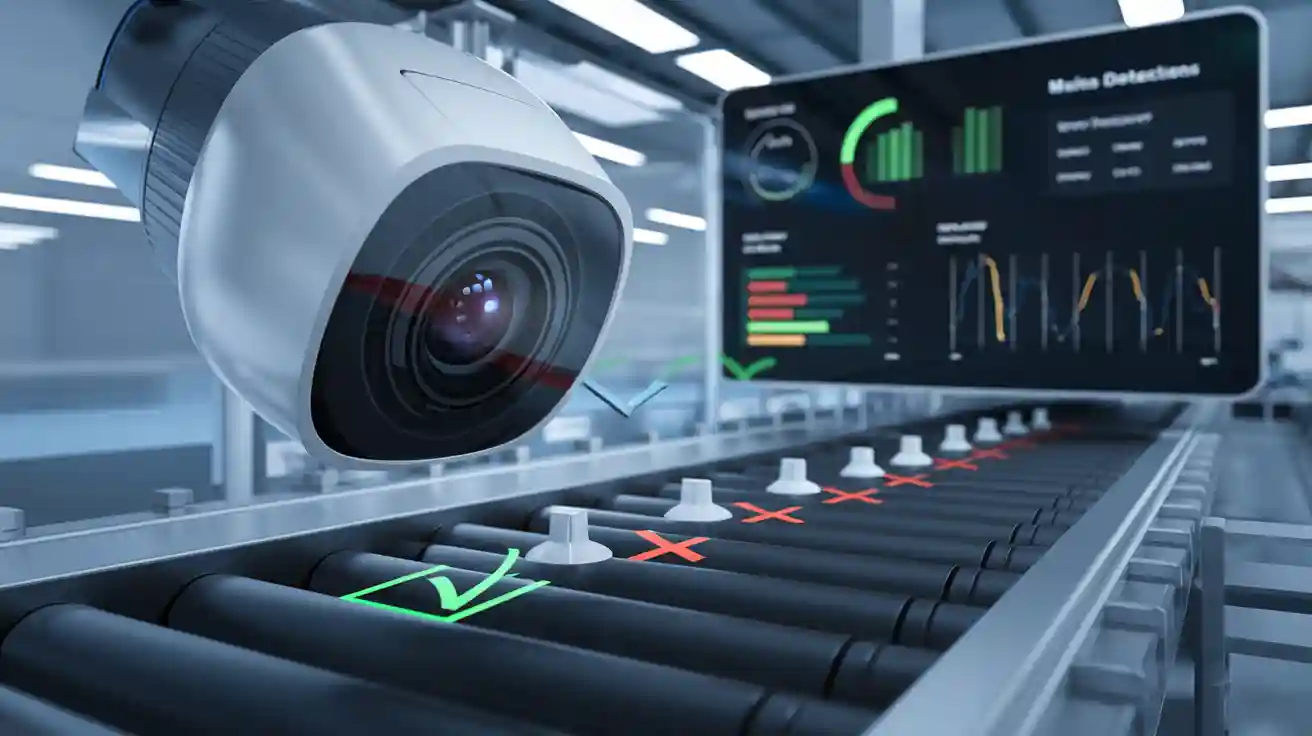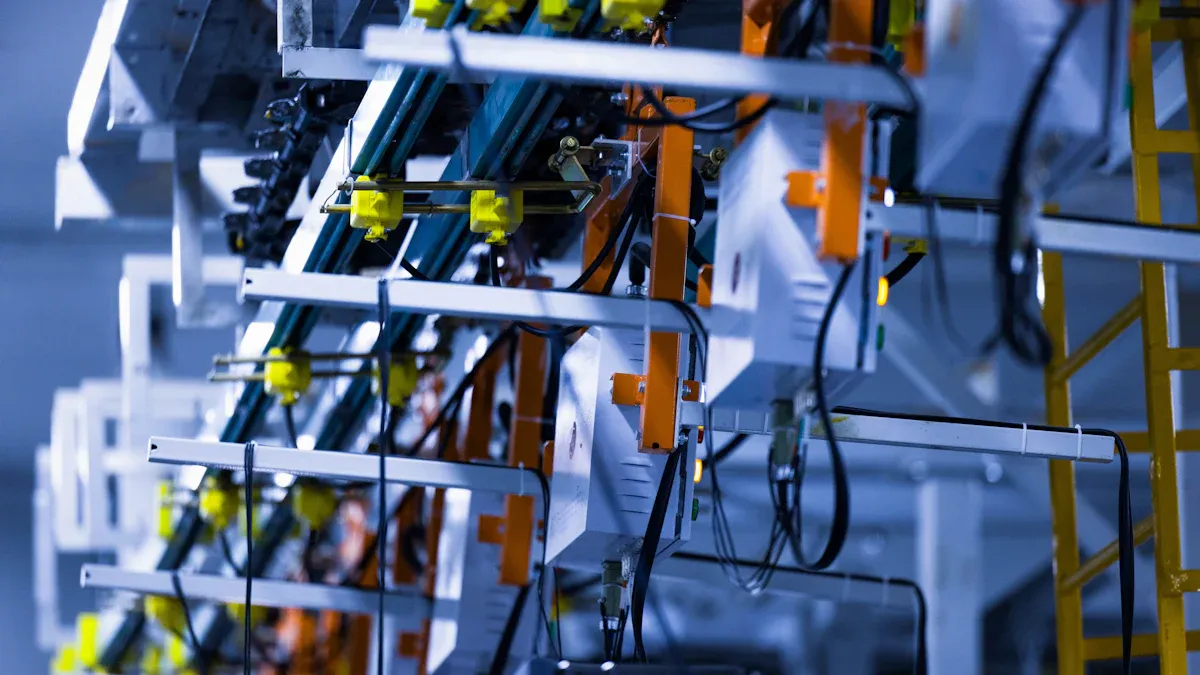
False negatives in a fn machine vision system often lead to missed detections, which can compromise the reliability of machine vision systems. In industries that rely on quality control, even a small increase in false negatives can result in defective products passing inspection. For example, in orthopedic surgical tray inspection, a 2% false negative rate sets a high standard for detection accuracy. Machine vision systems that minimize false negatives consistently deliver better accuracy and help maintain strict quality control requirements.
Key Takeaways
- False negatives occur when machine vision systems miss real objects or defects, lowering detection accuracy and risking product quality or safety.
- Reducing false negatives improves key performance metrics like recall and the F1 score, which are vital for reliable and balanced system results.
- High-quality, diverse data and careful model optimization help lower false negatives by teaching systems to recognize all relevant patterns.
- Regular system calibration and monitoring keep machine vision systems accurate and trustworthy, preventing missed detections over time.
- Minimizing false negatives protects product quality, enhances safety, and builds confidence in automated inspection processes across industries.
FN in Machine Vision Systems
What Is FN
In machine vision systems, a false negative happens when the system fails to detect an object or feature that actually exists in the real world. The fn machine vision system produces a negative result, even though the ground truth is positive. For example, in medical imaging, the system might miss a cancerous region, which could delay important treatment. This type of error means the system overlooks something it should have found. In industrial inspection, missing a defect can allow faulty products to reach customers.
FN in Classification
False negatives in classification tasks within machine vision systems appear as missed detections of real issues. These errors are known as Type II errors. For instance, in structural health monitoring, the fn machine vision system might fail to spot actual damage. This failure can lead to dangerous situations, as undetected problems may grow worse over time. False negatives often cause more concern than false positives because they let real defects pass through. This can increase risks, create legal problems, and force companies to add manual checks. As a result, the efficiency of automation drops, and trust in the machine vision system decreases.
Note: In safety-critical applications, reducing false negatives is more important than reducing false positives. Missed detections can have severe consequences for product quality and human safety.
Confusion Matrix
A confusion matrix helps evaluate the performance of machine vision systems. It shows how well the system predicts positive and negative cases. In this matrix:
- A false negative (FN) occurs when the model predicts a negative outcome, but the actual ground truth is positive.
- The columns represent the actual values, and the rows show the predicted values.
- The FN cell marks cases where the system misses something that is truly present.
- For example, if the system fails to identify a car in an image that actually contains a car, this counts as a false negative.
| Actual Positive | Actual Negative | |
|---|---|---|
| Predicted Positive | True Positive | False Positive |
| Predicted Negative | False Negative | True Negative |
The confusion matrix makes it easy to see how often the fn machine vision system misses real objects or defects. By studying this table, engineers can find ways to improve machine vision systems and reduce false negatives.
FN and Metrics
Accuracy
Accuracy stands as one of the most common performance metrics in machine vision systems. It measures how often the system correctly classifies items, whether as positive or negative. The formula for accuracy is:
Accuracy = (True Positives + True Negatives) / Total Inspections
False negatives reduce the number of true positives. When a machine vision system misclassifies a ‘GOOD’ part as ‘BAD’, it increases the count of false negatives. This action lowers the total number of correct classifications. For example, if a system inspects 1,000 parts and produces 4 false negatives, the accuracy drops from a perfect score to 99.4%. Even a small number of false negatives can cause a noticeable decrease in accuracy. This reduction highlights the importance of minimizing false negatives to maintain high accuracy in performance metrics.
Precision and Recall
Precision and recall are two critical performance metrics that provide deeper insight into a machine vision system’s effectiveness. Precision measures the proportion of positive identifications that are actually correct. The formula for precision is:
Precision = True Positives / (True Positives + False Positives)
False negatives do not directly affect precision. However, they play a major role in recall, which measures the system’s ability to find all actual positive cases. The formula for recall is:
Recall = True Positives / (True Positives + False Negatives)
When false negatives increase, recall decreases. This means the system misses more real positives, which can be critical in applications like defect detection or safety monitoring. High recall indicates that the system rarely misses positive cases. In contrast, low recall signals that the system often overlooks important items. Both precision and recall are essential performance metrics, but recall is especially sensitive to false negatives.
Note: In many industrial and safety applications, recall often takes priority over precision. Missing a defect or hazard can have serious consequences, so reducing false negatives is crucial for reliable system performance.
F1 Score
The F1 score combines precision and recall into a single performance metric. It uses the harmonic mean to balance both values, providing a more complete picture of system accuracy. The formula for the F1 score is:
F1 Score = 2 × (Precision × Recall) / (Precision + Recall)
False negatives have a direct impact on the F1 score. When false negatives increase, recall drops, which in turn lowers the F1 score. A high F1 score indicates that the machine vision system maintains a good balance between precision and recall. This balance is vital in real-world scenarios, where both missed detections and false alarms can cause problems. The F1 score penalizes systems with high false negatives, making it a valuable tool for evaluating overall performance.
| Metric | Formula | Impact of False Negatives |
|---|---|---|
| Accuracy | (TP + TN) / (TP + TN + FP + FN) | Lowers accuracy by reducing TP |
| Precision | TP / (TP + FP) | No direct effect |
| Recall | TP / (TP + FN) | Lowers recall by increasing FN |
| F1 Score | 2 × (Precision × Recall) / (Precision + Recall) | Lowers F1 score by reducing recall |
Minimizing false negatives is essential for strong performance metrics. It ensures that machine vision systems deliver reliable, accurate, and balanced results. By focusing on reducing false negatives, engineers can improve accuracy, recall, and the F1 score, leading to better outcomes in industrial and safety-critical applications.
Real-World Impact

Quality Control
Machine vision systems play a vital role in quality control across many industries. These systems inspect products on assembly lines, searching for defects that could affect performance or safety. When false negatives occur, defective items pass through undetected. This failure can lead to customer complaints, product recalls, and financial losses. Companies rely on machine vision systems to maintain high standards in quality control. Missed detections can damage a brand’s reputation and reduce consumer trust. In electronics manufacturing, for example, a single missed defect can cause device failure and costly warranty claims. Machine vision systems help manufacturers catch these issues early, but false negatives remain a challenge. As technology advances, machine vision systems now use artificial intelligence to improve detection rates and reduce errors. These improvements help companies achieve stricter quality control and deliver safer, more reliable products.
Safety Applications
Machine vision systems protect people and equipment in safety-critical environments. False negatives in these systems can create serious risks. When a system fails to detect a hazard, the consequences can be severe.
- Defective parts may pass inspection, threatening safety in industries like aerospace, automotive, and medical devices.
- Missed defects can cause equipment failures or injuries.
- Undetected cracks in airplane parts may lead to failures during flight.
- Companies may face product recalls, loss of reputation, and legal penalties.
Machine vision systems must minimize false negatives to ensure safety. Regular monitoring, better data quality, and improved algorithms help reduce these risks. Many industries now use advanced machine vision systems to enhance detection and protect both workers and consumers.
System Reliability
System reliability depends on the consistent performance of machine vision systems. False negatives reduce trust in automated inspection and detection processes. When a system misses defects, operators may need to add manual checks, which increases costs and slows production. Reliable machine vision systems allow companies to automate more tasks and reduce human error. The evolution of machine vision technology, especially with artificial intelligence and deep learning, has transformed how companies manage false negatives. AI-powered machine vision systems now detect subtle defects faster and more accurately than traditional methods. These systems classify defects precisely, helping manufacturers address problems quickly. Integration with robotics and augmented reality expands the capabilities of machine vision systems, making them more reliable in complex environments. Industries such as electronics, pharmaceuticals, automotive, and aerospace have adopted these advanced systems to improve quality control and detection reliability. As a result, machine vision systems now play a central role in modern manufacturing and industrial automation.
Reducing FN
Data Quality
High-quality data forms the foundation of accurate machine vision systems. Diverse and representative training datasets help reduce false negatives by ensuring the model learns from all relevant patterns. When datasets lack diversity, models often misclassify underrepresented groups, leading to higher false negative rates. For example:
- Training data should reflect the target population, including all relevant subgroups.
- Simply increasing dataset size does not guarantee better results; careful selection and characterization matter.
- Inclusive datasets help avoid social identity and information bias, which can cause missed detections.
A model trained on a narrow dataset may show high precision for some groups but fail for others. By collecting more representative data, engineers improve both recall and precision, lowering the risk of missed defects.
Model Optimization
Model optimization strategies directly impact false negative rates. Engineers use several techniques to improve detection and precision:
- Adjusting the decision threshold increases recall and reduces false negatives.
- Cost-sensitive learning assigns higher penalties to false negatives, encouraging the model to minimize these errors.
- Data augmentation introduces synthetic examples, improving generalization and precision.
- Ensemble methods like bagging and boosting combine multiple models for better accuracy.
- Feature engineering helps the model distinguish positive cases, increasing precision.
- Hyperparameter tuning refines model settings, further reducing false negatives.
Continuous monitoring and validation ensure the model maintains high precision and low error rates over time. These strategies help machine vision systems achieve a balance between recall and precision, especially in sensitive applications.
System Calibration
Ongoing calibration keeps machine vision systems reliable. Best practices include:
- Define clear metrics such as recall, precision, and defect detection rate.
- Prepare fair test groups to reduce bias.
- Run controlled A/B tests under consistent conditions.
- Analyze results with statistical rigor.
- Monitor false negatives and precision in production.
- Retrain models with new data to adapt to changes.
- Use data augmentation for robustness.
- Employ production best practices for reliable deployment.
Regular calibration and feedback loops help maintain high precision and low false negative rates, supporting long-term system performance.
Managing false negatives remains essential for optimal machine vision system accuracy. Missed detections allow defects to pass, which lowers recall and reduces product reliability. Companies can maintain high accuracy by using continuous monitoring, regular audits, and retraining with new data. They also benefit from practical strategies such as deep learning, hardware upgrades, and data-centric approaches. These steps help reduce false negatives and support reliable defect detection across industries.
FAQ
What is a false negative in machine vision?
A false negative happens when the system misses an object or defect that actually exists. The system reports everything is fine, but a problem remains undetected.
Why do false negatives matter in quality control?
False negatives allow defective products to pass inspection. This can lead to customer complaints, product recalls, and financial losses for companies.
How can engineers reduce false negatives?
Engineers improve data quality, optimize models, and calibrate systems regularly. These steps help the system detect more real issues and lower the false negative rate.
Do false negatives affect system trust?
Yes. When a system misses real problems, operators lose confidence. They may add manual checks, which increases costs and slows production.
Can machine vision systems eliminate all false negatives?
No system can guarantee zero false negatives. However, regular updates, better data, and advanced algorithms help reduce them to very low levels.
See Also
Do Filtering Techniques Improve Accuracy In Machine Vision?
The Effect Of Frame Rate On Machine Vision Efficiency
Comparing Firmware-Based And Traditional Machine Vision Systems
Machine Vision Methods For Precise Alignment In 2025
Understanding Camera Resolution Fundamentals In Machine Vision









